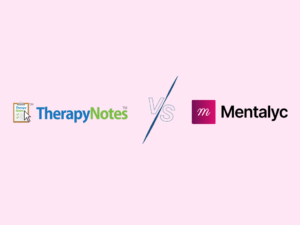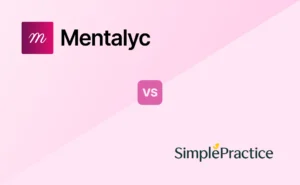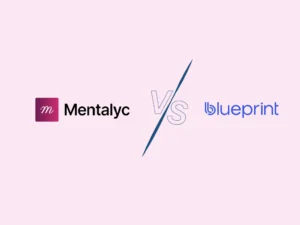Clinical Documentation Improvement (CDI) is very important in today’s modern healthcare, it ensures that notes and records about a client’s health are clear, complete, and correct. Therapists and other healthcare workers need these records to give the best care. If the notes are missing key details or contain errors, it can lead to the wrong diagnosis or poor treatment. This can eventually hurt the client’s health. The impact can be more severe such as damage to the reputation of the clinic or legal problems.
Understanding Clinical Documentation Improvement (CDI)
CDI is a process that healthcare workers use to check and improve client medical records. It helps make sure the notes give a full and true picture of the care a client receives. Many professionals work together on CDI like psychiatrists, nurses, therapists, and coding experts. They all help review the records to confirm they match the care provided.
Major Features of Clinical Documentation Improvement
1. Accuracy
Accuracy is an important aspect of client care documentation. Accurate documentation outlines the details of the care given to clients. It must explicitly state the diagnoses, treatment, response to treatment, and outcomes of client care. Accurate documentation also eliminates the possibility of ambiguities and uses the right coding in reporting care.
2. Completeness
A clinical note is only complete when it captures all the important client details. It should include the client’s history, symptoms, diagnosis, and observations. A complete clinical note must also contain the interventions and care plans given to a client. Completeness is an essential part of clinical documentation because gaps and missing details can lead to note misinterpretation, coding errors, and delayed reimbursement.
3. Specificity
CDI emphasizes specificity in clinical note documentation. In place of vague and general terms, healthcare providers should ensure they use specific terms that make the note easy to comprehend. For example, writing “Generalized anxiety disorder with panic attacks” is more specific than using a generic term like “Anxiety.” While the latter could be misinterpreted, the former helps healthcare practitioners to understand the client’s mental health history better. Specificity also leads to more precise coding and better risk adjustment.
4. Consistency
All entries in the client’s record across the organization must be consistent. For example, a progress note should not say the client is showing improvement if the clinical assessment indicates worsening symptoms. Contradictions in a client’s records can lead to compliance issues and affect treatment outcomes and reporting.
5. Clarity and Legibility
Clinical notes must be written clearly and legibly. Mental healthcare providers should avoid ambiguous language and abbreviations that could be misinterpreted. This ensures that interdisciplinary teams and coders understand the content of the client notes if they need to use it at any time.
6. Clinical Relevance
Client notes should contain complete information about clients. However, it shouldn’t be padded with excessive information that lacks clinical value. When writing your notes, make them robust, but avoid unnecessary details.
Purpose Of CDI
- It Ensures Documentations Reflect the True Status of the Client’s Health
Clinical documentation should reflect the health status of clients at every time. It needs to give a full picture of the health trajectory of clients, treatments received, and how they have progressed over time. CDI ensures that all symptoms, diagnoses, and treatments given to clients are captured correctly. They eliminate vagueness and ambiguities that could make the documentation unclear. With accurate documentation, healthcare teams can understand clients’ journeys perfectly. This reduces the risks of medication errors and ensures clients get the best care.
- It Reduces Claim Denial and Audit Risks
Insurance companies and audit teams review medical records before approving claims and payments. When documentation is not properly done, practices are at risk of experiencing claims denial and repayment demands. CDI reduces these risks by ensuring reports align with clinical language and use the appropriate coding structures. It also ensures that the documentation proves the need for treatment and makes claims processing faster.
- It Strengthens Legal Documentation and Compliance
Medical documents are sometimes used as legal documents during court proceedings and investigations. CDI ensures that these documents are well written and eliminates omissions and vague terms that could lead to legal complications. For example, a well-documented client note could serve as proof of professionalism and timely decision-making. In the absence of it, practices could be sued for negligence that led to complications.
- It Enhances Clinical Decision Making and Continuity of Care
Accurate documentation helps new healthcare providers assess previous care clients have received while helping them understand the next step. This is very important in mental health, chronic conditions, and multi-specialty care where clients see several practitioners. Continuity of care is easier when healthcare practitioners have access to clear and complete information about clients.
- It Supports Public Health, Research, and Policy Development
Healthcare documentation often feeds databases used by researchers, policymakers, and public health agencies. It is important for healthcare providers to maintain accurate records that could help these professionals track diseases, and evaluate treatment outcomes. By improving documentation, CDI ensures the accuracy and reliability of data entered into these databases. As a result, decisions made using them are from real and complete clinical scenarios. Hence, helping them arrive at credible conclusions that could aid public health interventions.
- It Reduces The Administrative Burden on Clinicians and Coders
CDI programs provide tools, templates, and staff support to healthcare providers. This helps them document more efficiently and accurately. During these training, care providers are also trained to recognize the important details that should be included in their report. When these reports are properly documented, there will be reduced corrections and queries. Consequently, ensuring that coders can process records quickly and with greater confidence in the submitted reports.
Best Clinical Documentation Improvement Practices
1. Establish A Multidisciplinary CDI Team
Having a successful CDI program starts with having the right team. Creating a multidisciplinary CDI team ensures all documentations are reviewed from the clinical, administrative, and coding perspectives. It is best for practices to have teams that comprise Physicians, Coding professionals, Quality and compliance officers, and Health Information Management (HIM) professionals. Crafting a team with persons from different disciplines bridges the gap between documentation, coding, and client care. It also enhances communication that could help prevent some mistakes before they arise.
2. Prioritize Education and Continuous Training
For a CDI to be sustainable, practices must prioritize education. They must ensure that all stakeholders understand the reason for proper documentation. CDI specialists should conduct regular training on the importance of specificity. The training should also outline the impact of documentation on quality metrics and client outcomes. When these trainings are conducted regularly, care providers will understand the best practices better and learn to embrace them.
3. Use Technology And AI-Powered Tools
With the consistent advancement of technology, manual documentation is no longer sufficient for handling client data. CDI programs commonly use tools like:
- Natural Language Processing: This will help them recognize documentation gaps almost immediately.
- Computer-Assisted Coding (CAC): It simplifies code assignment by automating some parts of the process. This helps reduce mistakes when assigning codes.
- CDI Software Platforms: These platforms have dashboards with performance metrics and query tracking.
These AI-driven tools have embedded features that help flag incomplete documentation. They can also assist with query suggestions and highlight records that need to be reviewed. Working with these tools helps CDI specialists to work more efficiently.
4. Emphasize Clinician Engagement and Accountability
CDI programs can’t thrive when clinicians and care providers don’t buy into it. Despite the busy schedule of clinicians, documentation improvement should be included in their workflow. To make it easier for your practice, have clinician liaisons and CDI experts. They will model the culture and ensure that several clinicians incorporate documentation best practices.
Giving individualized feedback could also help clinicians identify their strengths and weaknesses. This will spur them to make the necessary adjustments and get better. Another way to get clinicians involved is by incorporating CDI discussions in medical staff meetings and celebrating top performers. During the meeting, constantly reemphasize the impact of documentation on clients, the practice, and their performance rating.
5. Monitor Key CDI Metrics
The only way to know how well your practice’s CDI is faring is by consistent measurement. Some key CDI metrics you should look out for include:
- Query response and agreement rates
- Risk of Mortality (ROM) score
- Case Mix Index (CMI)
- Severity of Illness (SOI) Score
- Number of DRG shifts resulting from documentation changes
- Physician engagement and education effectiveness
- Financial impact of CDI interventions
Common Documentation Errors and How They Affect CDI
In Clinical Documentation Improvement (CDI), avoiding common mistakes is key to making client records clear and accurate. When notes are wrong or incomplete, it becomes hard to understand the care a client received. This can affect the quality of care, lead to confusion, and even cause legal or billing problems. Improving documentation by avoiding these common errors is a big part of what makes CDI work. Below are some common errors and tips to prevent them:
1. Leaving Out Important Information
If a therapist forgets to include key facts, the note doesn’t show the full picture of the session.
Error Example:
“Client seemed better today.”
Improved:
“Client reported sleeping 6 hours instead of 3, said they felt more hopeful, and smiled during most of the session.”
Tip: Write notes right after the session to capture all the important details.
2. Using Vague or Incorrect Terms
General or incorrect wording can confuse other healthcare providers who read the note.
Error Example:
“Client is doing okay.”
Improved:
“Client reported fewer panic attacks this week (1 instead of 4), and was able to attend school 3 days in a row.”
Tip: Be specific so it’s clear what “okay” really means.
3. Grammar and Spelling Errors
Mistakes can change the meaning or make the note hard to read.
Error Example:
“Clinet said he dosn’t feel safe at home.”
Improved:
“Client said he doesn’t feel safe at home.”
Tip: Use spell-check tools and read over your note before saving it.
4. Too Much or Too Little Detail
Writing too much can bury the main point. Too little can miss the important facts.
Too Much Example:
“A long story about what happened last summer with no link to today’s session…”
Too Little Example:
“Discussed past trauma.”
Improved:
“Client briefly shared a past trauma related to school bullying. Therapist provided support and will explore more in the next session.”
Tip: Focus on what’s most helpful for care planning.
5. Copy-Paste Errors
Copying old notes without updating them can lead to outdated or wrong information.
Error Example:
“Client still reports nightmares,” even though they said the nightmares stopped.
Improved:
“Client shared that the nightmares have reduced and only occurred once this week.”
Tip: Update every note to reflect what actually happened in the session.
Measuring the Success of CDI Programs
To know if a Clinical Documentation Improvement (CDI) program is working well, healthcare providers look at specific results. One way is by checking if the documentation is clearer, more complete, and accurate over time. Other signs of success include fewer claim denials from insurance companies, better communication between healthcare professionals, and improved quality of client care. For example, if a therapist’s notes are now detailed enough for the billing team to correctly code a session, that’s a win for CDI. Client satisfaction and fewer legal issues can also show that the program is making a difference.
Conclusion
Documentation plays a significant role in client care and practices. The impact of incorrect and incomplete documentation could affect practices and client care significantly. This necessitated the need for Clinical Documentation Improvement. CDI ensures that documentations capture the full details of client care. When documentation is well done, clients get access to better care and practices get more efficient in discharging their duties.
FAQs About CDI
Why Is CDI Important in Healthcare?
CDI impacts healthcare in several ways. When records are not properly documented, clients won’t get the best of care and this could affect their health gravely. CDI also impacts legal compliance, reimbursement, risk adjustment, and care continuity. When records are well documented, clients enjoy joy and better care, and practices have fewer claim denials.
What Is the Difference Between Medical Coding And CDI?
Medical coding translates healthcare documentation to the appropriate codes while CDI ensures that documentations are presented in clear and specific language.
Does CDI Affect Client Care Directly?
Yes, it does. Even though CDI is focused on documentation, the impact of poor or incorrect documentation could be grave. Such oversights could lead to missed diagnoses and inadequate care. This affects clients’ care negatively and could lead to health deterioration.
Is CDI only For In-client Settings?
No. CDI is important for all settings that deal with clients. This includes the emergency departments, behavioral health facilities, and post-acute care.
What Are the Common Documentation Gaps CDI Aims to Correct?
Some of the common issues CDI corrects in documentation include:
- Vague and unspecified diagnosis
- Missing documentation
- Incomplete capturing of severity or complications
- Absence of connection between diagnoses and symptoms.
What Are Clinical Queries In CDI?
Clinical queries in CDI are standardized requests that are sent to providers to request clarification and more documentation details. These queries could be verbal or written. They could also come in multiple-choice and open-ended formats.
References:
- AAPC (American Academy of Professional Coders). (n.d.). What is clinical documentation improvement (CDI)?
- American Health Information Management Association (AHIMA). (n.d.). Clinical documentation integrity toolkit for beginners.
- Canadian Health Information Management Association (CHIMA). (2019). An essential guide to clinical documentation improvement.
Why other mental health professionals love Mentalyc

“By the end of the day, usually by the end of the session, I have my documentation done. I have a thorough, comprehensive note … It’s just saving me hours every week.”
CDCII

“Having Mentalyc take away some of the work from me has allowed me to be more present when I’m in session with clients … it took a lot of pressure off.”
LPC

“It takes me less than 5 minutes to complete notes … it’s a huge time saver, a huge stress reliever.”
Licensed Marriage and Family Therapist

“It’s so quick and easy to do notes now … I used to stay late two hours to finish my notes. Now it’s a breeze.”
Licensed Professional Counselor







